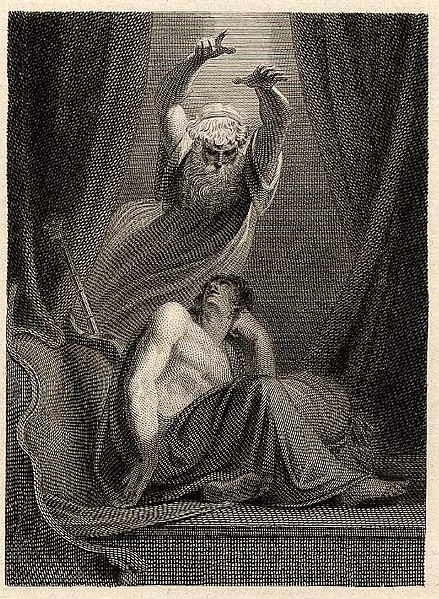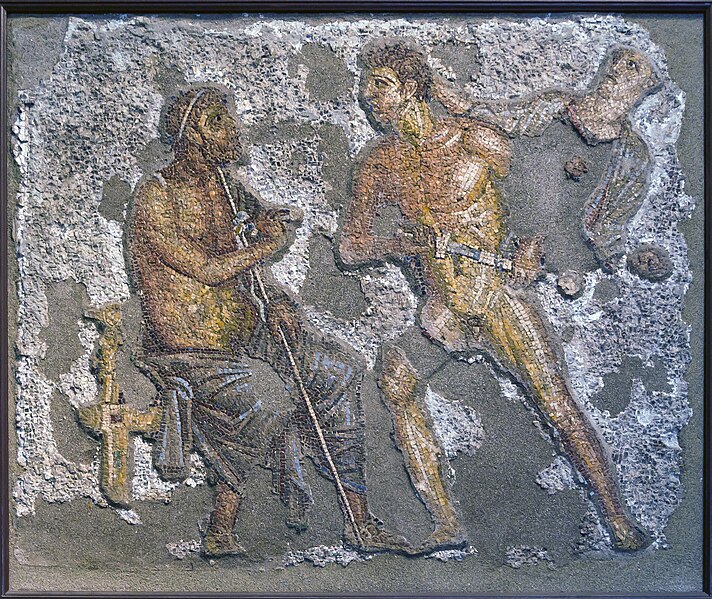In the annals of Greek mythology, few names command as much respect and intrigue as Agamemnon. As the king of Mycenae and a central figure in the Trojan War, his legacy is one of power, strategy, and tragic fate.
Key Facts
| Keyword | Fact |
| Parents | Atreus and Aerope |
| Partners | Clytemnestra |
| Siblings | Menelaus |
| Offspring | Iphigenia, Electra, Orestes, Chrysothemis |
| Other names | N/A |
| Roman name | Agamemnon |
| Best Known Myth | His leadership in the Trojan War and tragic homecoming |
Name and Etymology
The name Agamemnon resonates with authority and leadership. Derived from the Greek “Agamémnon,” it can be loosely translated to “very steadfast” or “unyielding.” Such a name aptly fits a king known for his determination and strategic prowess. In Roman tales, he retains his Greek name, a testament to his unparalleled stature in mythology.
Throughout various accounts, Agamemnon is often referred to by his title, the King of Mycenae, emphasizing his royal lineage and authority. While he doesn’t possess a plethora of epithets like some other figures in Greek myths, his name alone stands as a symbol of might and tragic destiny.
In both Greek and Roman retellings, Agamemnon’s tales are pivotal, showcasing the complexities of leadership, the burdens of responsibility, and the inescapable nature of fate.

Agamemnon’s Family and Relationships
Born to Atreus and Aerope, Agamemnon was destined for greatness from the very beginning. His lineage was steeped in power, with his father being a significant figure in Greek mythology. Alongside his brother, Menelaus, Agamemnon’s tales are intertwined with the larger narrative of the Trojan War and its aftermath.
His birth and early years were marked by prophecies and omens, hinting at his future role and the tragedies that would befall him. As he grew, so did his reputation, eventually becoming the King of Mycenae.
His marriage to Clytemnestra, though initially filled with love, became strained due to the weight of his decisions, especially the sacrifice of their daughter, Iphigenia. This act, done to appease the goddess Artemis, would set the stage for a series of tragic events upon his return from Troy.
Iphigenia
Iphigenia is perhaps the most tragic figure among Agamemnon’s children. In order to appease the goddess Artemis and ensure the Greek fleet could sail to Troy, Agamemnon was compelled to sacrifice Iphigenia. However, some versions of the myth suggest that Artemis replaced Iphigenia with a deer at the last moment, sparing her life and whisking her away to Tauris, where she became a priestess.
Electra
Electra’s life was marked by the quest for revenge. After the murder of Agamemnon by Clytemnestra, her mother, and Aegisthus, her mother’s lover, Electra played a crucial role in avenging her father’s death. Alongside her brother Orestes, she plotted and executed the murder of Clytemnestra and Aegisthus, a tale that has been the subject of numerous plays and literary works.
Orestes
Orestes, after avenging his father’s death with the help of Electra, was tormented by the Erinyes (Furies) for the matricide. He sought purification and was eventually put on trial by the gods in Athens. With Athena’s intervention, he was acquitted, and the wrath of the Erinyes was appeased. Orestes later became the king of Mycenae and Argos, uniting the two kingdoms.
Agamemnon Games
Do you want to test your knowledge about Agamemnon and other Greek heroes? Play this game:
Don’t forget to try our other games as well!
Myths about Agamemnon
Agamemnon’s life is a rich tapestry of victories, sacrifices, and tragedies. As the King of Mycenae, his influence was vast, and his decisions, both good and ill, shaped the course of Greek mythology. Let’s delve deeper into the myths that defined this legendary king.
Leadership in the Trojan War
The Trojan War, a conflict that spanned a decade, saw Agamemnon at the helm of the Greek forces. His leadership was instrumental in rallying the various Greek city-states, uniting heroes like Achilles, Odysseus, and Ajax under a common banner. However, his role was not without its challenges.
One of the most significant disputes was with Achilles over the war prize, Briseis. This disagreement led to Achilles’ temporary withdrawal from the war, a move that had dire consequences for the Greeks. Agamemnon’s ability to navigate such intricate politics and personal conflicts showcased his leadership skills, albeit with certain flaws.
The Sacrifice of Iphigenia and Divine Interference
Before the Greek fleet could set sail for Troy, they found themselves stranded, unable to progress due to unfavorable winds. The seer Calchas, The Interpreter of Omens revealed that the winds were a result of Agamemnon’s offense to the goddess Artemis. To appease her and ensure a safe voyage to Troy, Agamemnon faced the heart-wrenching decision to sacrifice his daughter, Iphigenia.
This act, while securing the goddess’s favor, sowed seeds of resentment in his wife, Clytemnestra, setting the stage for future tragedies. Some versions of the myth suggest that Artemis, moved by Iphigenia’s willingness to sacrifice herself, replaced her with a deer at the last moment, sparing her life and whisking her away.
Agamemnon and the Fall of Troy
Agamemnon’s strategic acumen was evident during the siege of Troy. While the war saw many heroes shine, Agamemnon’s leadership was a constant, guiding the Greeks through victories and setbacks. He played a crucial role in the war council. Deliberating on strategies such as the famous Trojan Horse, a deceptive ploy that ultimately led to the fall of Troy.
His interactions with other heroes, especially his attempts to reconcile with Achilles after Patroclus’ death, highlight his multifaceted personality. Both as a king and as a man trying to mend his mistakes.
The Tragic Homecoming and the Curse of the House of Atreus
Upon the fall of Troy, Agamemnon returned to Mycenae with Cassandra, the Trojan princess and Apollo’s cursed prophetess, as his concubine. His triumphant return, however, was overshadowed by the brewing storm at home. Clytemnestra, still harboring deep-seated anger over Iphigenia’s sacrifice and now enraged by Cassandra’s presence, conspired with her lover, Aegisthus, to murder Agamemnon.
This act was not just a culmination of personal vendettas however. It was also a continuation of the curse of the House of Atreus. A lineage marred by betrayals and bloodshed. Agamemnon’s death set off a chain of events, leading his son, Orestes, on a quest for vengeance, further perpetuating the cycle of tragedy.
In these myths, Agamemnon emerges as a complex figure, a blend of strength and vulnerability. His decisions, both wise and ill-advised, shaped the course of events in Greek mythology. Furthermore making him one of its most pivotal characters.
Depiction And Characteristics
Agamemnon, in myths and art, is often portrayed as a majestic king, embodying the essence of leadership and authority. He’s typically depicted with a scepter, symbolizing his rule, and wearing a crown or helmet, indicative of his royal status.
His personality, as portrayed in myths, is multifaceted. While he’s a strategic leader and warrior, he’s also a father and husband, torn between duty and family. The Ancient Greeks viewed him as a tragic figure, a king bound by fate and destiny.
Symbols like the scepter and the throne are frequently associated with Agamemnon, emphasizing his royal lineage and authority. Animals like the eagle, representing power and kingship, are often linked to him.
Representations Of Agamemnon In Art
Art has immortalized Agamemnon in various forms. From intricate pottery designs depicting scenes from the Trojan War to grand statues showcasing his regal stature, his presence is felt across Greek art. The “Mask of Agamemnon,” a gold funeral mask discovered at Mycenae, is one of the most iconic representations, though its authenticity as Agamemnon’s mask is debated.
His tragic tale, especially his homecoming and subsequent murder, has been a recurrent theme in plays, paintings, and sculptures, capturing the essence of his life and the inevitable nature of his fate.
Mentions in Ancient Texts
Agamemnon’s legacy extends far beyond myths, finding its way into the heart of ancient literature. Several renowned authors have immortalized him in their works, each offering a unique perspective on the King of Mycenae.

Homer’s “Iliad” and “Odyssey”
Homer, the legendary blind poet of ancient Greece, provides one of the most comprehensive accounts of Agamemnon’s role in the Trojan War through his epic, the “Iliad.” This monumental work delves deep into the final year of the Trojan War. Furthermore highlighting Agamemnon’s leadership, his conflicts with other heroes, especially Achilles, and his strategic acumen. The “Iliad” paints a multifaceted picture of Agamemnon, showcasing both his strengths and flaws.
In the “Odyssey,” another of Homer’s masterpieces, Agamemnon’s tragic fate post the Trojan War is recounted. His murder at the hands of Clytemnestra and Aegisthus serves as a cautionary tale for Odysseus. Warning him of the dangers that might await at home. Through the ghost of Agamemnon, met in the Underworld by Odysseus, we hear firsthand the lament of the fallen king. Learning about the treachery that befell him.
Aeschylus’ “The Oresteia”
Aeschylus, one of the three great tragedians of classical Athens, crafted “The Oresteia,” a trilogy that delves deep into the tragedies of Agamemnon’s family. The first play, “Agamemnon,” recounts the king’s triumphant return from Troy and his subsequent murder. Aeschylus paints a vivid picture of the curse of the House of Atreus, the intricate web of revenge, and the moral dilemmas faced by its members. Through this work, we gain a deeper understanding of the consequences of Agamemnon’s decisions and the tragic fate that befalls him and his lineage.
Euripides’ Take on the Tale
Euripides, another of the famed Athenian tragedians, offers a different perspective on Agamemnon’s tale, especially concerning Iphigenia. In “Iphigenia at Aulis,” Euripides delves into the emotional turmoil surrounding the decision to sacrifice Iphigenia. The play captures the tension, the heartbreak, and the moral quandaries faced by Agamemnon, torn between duty and fatherly love.
In these ancient texts, Agamemnon emerges not just as a historical or mythical figure. Moreover he is a symbol of leadership, sacrifice, and the tragic weight of destiny. His story, as told by these literary giants, continues to resonate. Furthermore offering insights into the human condition and the complexities of heroism and leadership.
Frequently Asked Questions
Agamemnon was the leader of the Greek forces during the Trojan War, uniting various Greek city-states and heroes under one banner to lay siege to Troy.
The sacrifice was made to appease the goddess Artemis and ensure favorable winds for the Greek fleet. However, this act deeply angered his wife, Clytemnestra, setting the stage for future betrayals and tragedies upon his return.
He brought back Cassandra, a prophetess cursed by Apollo, as his concubine after the fall of Troy.
Upon his return to Mycenae, Agamemnon was murdered by his wife, Clytemnestra, and her lover, Aegisthus, as revenge for the sacrifice of Iphigenia and his relationship with Cassandra.
Aeschylus, in his trilogy “The Oresteia,” and Euripides, in plays like “Iphigenia at Aulis,” delved deep into Agamemnon’s life, decisions, and tragic consequences.
The House of Atreus was plagued by a cycle of betrayals, revenge, and bloodshed. Agamemnon’s life and decisions, especially his conflicts and tragic end, are seen as a continuation of this cursed lineage.
Featured Image Credit: Giulio Romano, Public domain, via Wikimedia Commons
